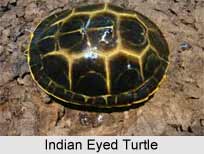 Indian Eyed Turtle is an Indian reptile that bears a scientific name "Morenia petersi" found in Assam, Gawahati, water belt in Brahmaputra River Valley and Bihar. Indian Eyed Turtle is also found in Huzurapur (Jessore District of Bangladesh), Faridpur and Dhaka, Bangladesh.
Indian Eyed Turtle is an Indian reptile that bears a scientific name "Morenia petersi" found in Assam, Gawahati, water belt in Brahmaputra River Valley and Bihar. Indian Eyed Turtle is also found in Huzurapur (Jessore District of Bangladesh), Faridpur and Dhaka, Bangladesh.
Snout of Indian Eyed Turtle
Indian Eyed Turtle is very closely allied to Morenia ocellata. The snout of Indian Eyed Turtle is much more pointed and relatively longer.
Suture of Indian Eyed Turtle
The suture of Indian Eyed Turtle lies in between the pectorals is not shorter than the suture between the abdominals.
Carapace of Indian Eyed Turtle
The carapace of Indian Eyed Turtle is black, each vertebral has a narrow yellowish mesial line. The last four vertebrals have a yellowish linear horseshoe mark with both ends directed forward. All costal have an ocellus placed rather low and formed by a narrow yellowish line, above which are some irregular looped lines of similar colour. The nuchal and each marginal have a narrow, vertical yellowish mesial streak.
Plastron of Indian Eyed Turtle
The plastron of Indian Eyed Turtle is yellow. There are three yellow streaks on each side of the head, the lower one extending from below the nostril to the angle of the mouth.
Shell of Indian Eyed Turtle
The male Indian Eyed Turtle can achieve a shell length of up to 5 (about 12 cm) inches, females can achieve a shell length of up to 8 (about 20 cm) inches.
Egg of Indian Eyed Turtle
The mating of Indian Eyed Turtle occurs in the winter months, and nesting follows in April-May. A clutch of Indian Eyed Turtle is made up of two eggs (34.6-35 cm x 22 cm).



















